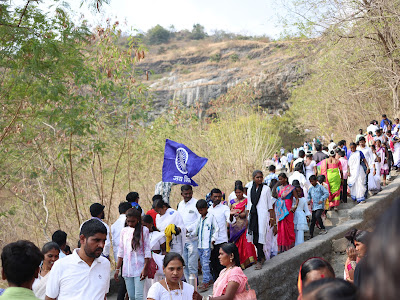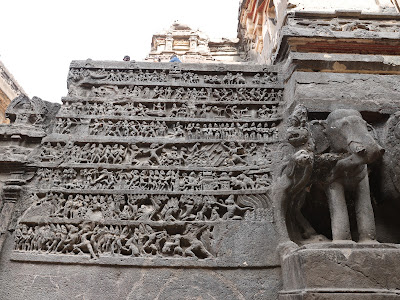We left early to get to Chhatrapati Shivaji Nagar, formerly known as Aurangabad. We arrived just when the most important festival in the city was being held, and the streets were dedicated to the festival, which included the places we planned to visit.
After moving with determination through the bustling group at the box office, we began our climb. Soon the photo requests and the questions of: "What country do you come from?" began. Finally, we arrived at the level of the caves and really what we did was a photo shoot, of which Marce took advantage to record the faces of the place. She tried to get into one of the largest caves, but couldn't advance more than 2 metres because she was always surrounded by people who wanted to take pictures with her. So she decided to leave the place to meet Alan again, who was calling, but Ishe didn't find him because he was also surrounded by young people who surrounded him completely.
We decided to descend and, along the way, we were presented with another set of photographic experiences, protection and love with generosity.
Another surprise was Bibi Ka Maqbara, a mausoleum built in 1669 in honour of the emperor's wife, ordered by his son. It is an impressive building of Mughal architecture, known as the Taj Mahal of Deccan. Built in marble and sandstone, with Islamic and Persian decorative elements, it is dazzling and cosy.
Aurangabad is famous for the Himroo, a form of textile that dates back to the 14th century. It is characterised by the elaboration of high quality fabrics, usually made of a mixture of silk and wool or silk and cotton, with metallic threads that present complex floral and geometric designs. This artisan process involves the use of manual looms and is based on colours such as black, mustard, or pale slate, and intricate patterns, making the pieces highly attractive.
The visit to the Ellora caves took us a whole day and we did not manage to visit all the caves. The Ellora Caves are an impressive complex of rock-dug temples and monasteries, dating between the 5th and 13th centuries. This heritage site, recognised by UNESCO, houses structures of three religions: Hinduism, Buddhism and Jainism, reflecting the tolerance and coexistence of these traditions in ancient India.
The caves extend over approximately 2 kilometres and have a total of 34 caves, the most prominent being Cave 16, known as the Temple of Kailash. This temple, built between the 7th and 8th centuries under the reign of the Rashtrakuta dynasty, is dedicated to the Hindu god Shiva and represents the sacred Kailash mountain.
The structure of the temple was carved from a single rock, from top to bottom, rather than being built with stone blocks. With a height of approximately 30 metres, the temple has an elaborate facade adorned with intricate sculptures representing deities, dances and mythological scenes. Among the most impressive representations are the Nataraja (Shiva dancing) and other figures that evoke the rich Hindu mythology.
In a beautiful mountainous setting next to the Waghora River, are the Ajanta caves, famous for their exceptional Buddhist art. The Ajanta complex comprises 30 caves, many of which are adorned with intricate sculptures, reliefs and frescos that represent the life of Buddha, stories of jataka (previous lives of Buddha) and various Buddhist representations.
The caves are mainly organised into two groups: the monastic (viharas) and the cult (chaityas). Viharas served as residences for monks, while chaityas are prayer temples that usually contain stupas, structures that house Buddhist relics.
The beauty of the place, the aesthetic richness of the caves, the presence of monks who visit, pray and meditate, and the warmth of the people we met, placed this experience in a special place of our consciousness.
Upon arriving at the hotel, we met the guys at the reception playing carom. This is a popular board game originally from India, which is played on a square board made of wood, with a design that includes a group of holes in each corner. With a style similar to billiards, the goal of the game is to slide the chips (discs) into the holes using a "striker" (a larger disc). Players must hit
the tiles with precision and strategy, trying to hit their own while avoiding the opponent's.
The game can be played by two to four players, organised in teams, and generally uses a set of nine tiles of each colour (white and black), plus a queen's tile that grants additional points. The game is won by being the first player or team to fetch all his chips, but the queen must also be considered, who must be ambushed before the end of the game.
An enriching experience in every sense, so much so that learning and discovering that time goes between our hands trying to answer our questions at some level.
Alan & Marce
En español
Salimos temprano para llegar a Chhatrapati Shivaji Nagar, antes conocida como Aurangabad. Llegamos justo cuando se celebraba el festival más importante de la ciudad, y las calles estaban dedicadas a la festividad, lo que incluía los lugares que planeábamos visitar.
Fuimos a las cuevas de Aurangabad y encontramos un mar de personas bellamente vestidas visitando el lugar. En términos históricos, estas cuevas budistas datan del siglo VI y tienen características similares a las que visitamos en Nashik.
Después de movernos con determinación a través del bullicioso grupo en la taquilla, comenzamos nuestros ascensos. Pronto comenzaron los pedidos de fotos y las preguntas de: "¿De qué país vienen?". Finalmente, llegamos al nivel de las cuevas y realmente lo que hicimos fue una sesión de fotos, que aproveché para registrar los rostros del lugar. Intenté entrar en una de las cuevas más grandes, pero no logré avanzar más de 2 metros porque siempre estaba rodeada de personas que querían hacerse fotos conmigo. Así que decidí dejar el lugar para reencontrarme con Alan, que me estaba llamando, pero no lo encontré porque él también estaba rodeado de jóvenes que lo tapaban por completo.
Decidimos descender y, en el camino, se nos presentaron otro conjunto de experiencias fotográficas, de protección y de amor con generosidad.
Otra sorpresa fue Bibi Ka Maqbara, un mausoleo construido en 1669 en honor a la esposa del emperador, ordenado por su hijo. Es un edificio impresionante de arquitectura mogol, conocido como el Taj Mahal de Deccan. Construido en mármol y arenisca, con elementos decorativos islámicos y persas, resulta deslumbrante y acogedor.
Aurangabad es famosa por el Himroo, una forma de textil que se remonta al siglo XIV. Se caracteriza por la elaboración de tejidos de alta calidad, generalmente hechos de una mezcla de seda y lana o seda y algodón, con hilos metálicos que presentan complejos diseños florales y geométricos. Este proceso artesanal implica el uso de telares manuales y se basa en colores como el negro, mostaza o pizarra pálido, y patrones intrincados, haciendo que las piezas resulten altamente atractivas.
La visita a las cuevas de Ellora nos llevó un día entero y no logramos visitar todas las cuevas. Las Cuevas de Ellora son un impresionante complejo de templos y monasterios excavados en roca, que datan entre los siglos V y XIII. Este sitio patrimonial, reconocido por la UNESCO, alberga estructuras de tres religiones: hinduismo, budismo y jainismo, reflejando la tolerancia y coexistencia de estas tradiciones en la India antigua.
Las cuevas se extienden a lo largo de aproximadamente 2 kilómetros y cuentan con un total de 34 cuevas, siendo la más destacada la Cueva 16, conocida como el Templo de Kailash. Este templo, construido entre los siglos VII y VIII bajo el reinado de la dinastía Rashtrakuta, está dedicado al dios hindú Shiva y representa la montaña sagrada Kailash.
La estructura del templo fue tallada a partir de una sola roca, de arriba hacia abajo, en lugar de ser construida con bloques de piedra. Con una altura de aproximadamente 30 metros, el templo presenta una elaborada fachada adornada con intrincadas esculturas que representan deidades, danzas y escenas mitológicas. Entre las representaciones más impresionantes se encuentran el Nataraja (Shiva danzando) y otras figuras que evocan la rica mitología hindú.
En un hermoso entorno montañoso junto al río Waghora, se encuentran las cuevas de Ajanta, famosas por su excepcional arte budista. El complejo de Ajanta comprende 30 cuevas, de las cuales muchas están adornadas con intrincadas esculturas, relieves y frescos que representan la vida de Buda, historias de jataka (vidas anteriores de Buda) y diversas representaciones budistas.
Las cuevas están organizadas principalmente en dos grupos: las monásticas (viharas) y las de culto (chaityas). Las viharas sirvieron como residencias para los monjes, mientras que los chaityas son templos de oración que suelen contener stupas, estructuras que albergan reliquias budistas.
La belleza del lugar, la riqueza estética de las cuevas, la presencia de monjes que visitan, oran y meditan, y la calidez de las personas que encontramos, ubicaron esta experiencia en un lugar especial de nuestra conciencia.
Al llegar al hotel, nos encontramos con los chicos de la recepción jugando al carrom. Este es un popular juego de mesa originario de India, que se juega en un tablero cuadrado hecho de madera, con un diseño que incluye un grupo de agujeros en cada esquina. Con un estilo similar al billar, el objetivo del juego es deslizar las fichas (discos) hacia los agujeros utilizando un "striker" (un disco más grande). Los jugadores deben golpear las fichas con precisión y estrategia, tratando de embocar las propias mientras evitan las del oponente.
El juego puede ser jugado por dos a cuatro jugadores, organizados en equipos, y generalmente utiliza un conjunto de nueve fichas de cada color (blancas y negras), más una ficha de reina que otorga puntos adicionales. La partida se gana al ser el primer jugador o equipo en embocar todas sus fichas, pero también se debe considerar la reina, que debe ser embocada antes de finalizar el juego.
Una experiencia enriquecedora en todos los sentidos, tanto que aprender y descubrir que se nos va el tiempo entre las manos intentando responder a algún nivel nuestra preguntas.
Alan y Marce















No comments:
Post a Comment